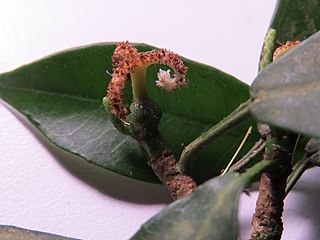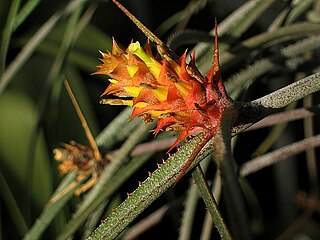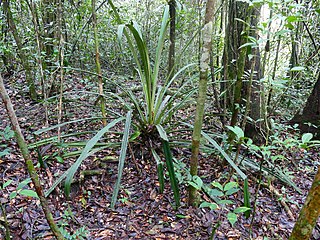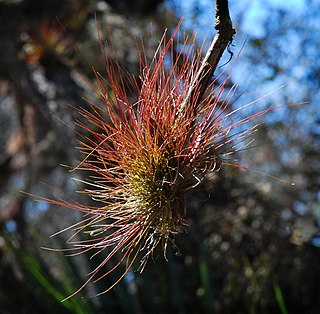Caryodendron is a plant genus of the family Euphorbiaceae first described as a genus in 1860. The genus includes C. orinocense, known as the Inchi tree or Tacay nut. It is native to Central America and South America. They are dioecious trees.
- Caryodendron amazonicumDucke - Amazonas in Brazil
- Caryodendron angustifoliumStandl. - Costa Rica, Panama, Colombia
- Caryodendron janeirenseMüll.Arg. - Rio de Janeiro
- Caryodendron orinocenseH.Karst - Colombia, Venezuela, Ecuador

Algernonia is a plant genus of the family Euphorbiaceae first described as a genus in 1858. It is native to Peru and Brazil.

Fosterella is a genus of plants in the family Bromeliaceae, subfamily Pitcairnioideae. It contains 31 recognized species, 30 native to central and western South America, one to Mesoamerica. The genus is named after Mulford B. Foster, American horticulturist and collector (1888-1978).

Campomanesia is a genus in the family Myrtaceae described as a genus in 1794. It is native to South America and Trinidad.

Acanthostachys is a genus of the botanical family Bromeliaceae, subfamily Bromelioideae. The genus name is from the Greek “acanthos” and “stachys”.

Disteganthus is a genus of plants in the family Bromeliaceae, subfamily Bromelioideae. The genus name is from the Greek “dis” (two), “steg” (covering), and “anthos” (flower). They are considered a primitive genus among bromeliads and are only found in terrestrial environments. Distenganthus has three known species, native to northeastern South America.

Blepharocalyx is a genus of plant in family Myrtaceae first described as a genus in 1854. It is native to South America and the West Indies.
- Blepharocalyx cruckshanksii(Hook. & Arn.) Nied. - Chile
- Blepharocalyx eggersii(Kiaerskou) L.R.Landrum - Lesser Antilles, Venezuela, Guyana, Peru, Brazil
- Blepharocalyx myriophyllus Mattos - Minas Gerais
- Blepharocalyx salicifolius(Kunth.) O.Berg - Brazil, Bolivia, Peru, Ecuador, Paraguay, Uruguay, N Argentina

Araujia is a small genus of perennial vines in the dogbane family first described as a genus in 1817. The group is native to South America.
- Araujia angustifolia(Hook. & Arn.) Steud. - Brazil, Paraguay, Uruguay, NE Argentina
- Araujia graveolens(Lindl.) Mast. - Brazil
- Araujia herzogii(Schltr.) Fontella & Goyder - Bolivia
- Araujia hortorumE.Fourn. - Brazil, Paraguay, Uruguay, NE Argentina
- Araujia megapotamica(Spreng.) G.Don - Brazil, Uruguay, NE Argentina
- Araujia plumosaSchltr. - Brazil, Paraguay, Bolivia, NW Argentina
- Araujia sericiferaBrot. - white bladderflower, cruel vine - Peru, Brazil; naturalized in parts of South Africa + United States
- Araujia stuckertiana(Kurtz ex Heger) Fontella & Goyder - Cordoba in Argentina
- Araujia subhastataE.Fourn. - Brazil

Bixa is a genus of plants in the family Bixaceae. It is native to Mexico, Central America, Caribbean, and South America, and naturalized in other places.
Aechmea atrovittata is a species of flowering plant in the genus Aechmea. This species is endemic to the State of Alagoas in eastern Brazil.
Wittmackia bicolor is a species of flowering plant in the family Bromeliaceae, endemic to south Brazil. It was first described by Lyman Bradford Smith in 1955 as Aechmea bicolor.

Aechmea marauensis is a species of flowering plant in the genus Aechmea. This species is endemic to the State of Bahia in eastern Brazil.
Guzmania melinonis is a species of plant in the genus Guzmania. This species is native to Bolivia, Peru, Colombia, the Guianas, Venezuela, Amazonas State of Brazil, and Ecuador.
Guzmania patula is a plant species in the genus Guzmania. This species is native to Costa Rica, Panama, Colombia, Venezuela, Ecuador, and the State of Amazonas in Brazil.
Aechmea egleriana is a plant species in the genus Aechmea. This species is native to Venezuela, French Guiana and northern Brazil.

Constantia is a genus of flowering plants from the orchid family, Orchidaceae. It contains 6 known species, all endemic to Brazil:
- Constantia australis(Cogn.) Porto & Brade - Santa Catarina
- Constantia cipoensisPorto & Brade - Minas Gerais
- Constantia cristinaeF.E.L.Miranda - Minas Gerais
- Constantia gutfreundianaChiron & V.P.Castro - Minas Gerais
- Constantia microscopicaF.E.L.Miranda - Minas Gerais
- Constantia rupestrisBarb.Rodr. - Rio de Janeiro

Tillandsia setacea, the southern needleleaf, is a species of flowering plant in the genus Tillandsia. It has a scattered, disjunct distribution in the southeastern United States, northwestern and southern Mexico, Guatemala, the West Indies and the State of Pará in northeastern Brazil.

Syagrus weddelliana, also known as the miniature coconut palm or Weddell's palm, is a feather palm in the palm family.

Herreria is a genus of flowering plants native to South America. In the APG III classification system, the genus is placed in the family Asparagaceae, subfamily Agavoideae.
- Herreria bonplandiiLecomte - Argentina, Paraguay, Uruguay
- Herreria cipoanaRavenna - Minas Gerais
- Herreria glazioviiLecomte - Bolivia, Brazil
- Herreria grandifloraGriseb. - Rio de Janeiro
- Herreria latifoliaWoodson - Minas Gerais, Bolivia
- Herreria montevidensisKlotzsch ex Griseb. in C.F.P.von Martius - Argentina, Paraguay, Uruguay, Bolivia
- Herreria salsaparilhaMart. - Brazil
- Herreria stellataRuiz & Pav. - Chile












